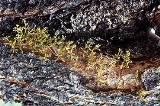
Arceuthobium americanum
Encyclopedia
Arceuthobium americanum is a species of dwarf mistletoe
known as American dwarf mistletoe and lodgepole-pine dwarf mistletoe. It is a common plant of western North America where it lives in high elevation pine forests. It is a parasitic plant
which lives upon the Lodgepole Pine
, particularly the subspecies Pinus contortus ssp. murrayana, the Tamarack Pine. This pine subspecies is most common in the Cascade Range
and Sierra Nevada
. The American dwarf mistletoe is a yellow-green coral-shaped structure above the surface of the tree's bark, while most of the parasite is beneath the bark. The seeds mature in late summer and disperse to nearby trees.
The parasitic plant is dioecious, meaning that it has separate male and female parts. Studies of pine needles from infected trees have shown decreased starch content in the needles of infected trees. Furthermore, differences have been found in the positioning of the vascular bundles between female infected pine trees and male infected pine trees.
Arceuthobium
The genus Arceuthobium, commonly called Dwarf Mistletoes, is a genus of 42 species of parasitic plants that parasitize members of Pinaceae and Cupressaceae in North America, Central America, Asia and Africa. Of the 42 species, 39 and 21 are endemic to North America and the United States, respectively...
known as American dwarf mistletoe and lodgepole-pine dwarf mistletoe. It is a common plant of western North America where it lives in high elevation pine forests. It is a parasitic plant
Parasitic plant
A parasitic plant is one that derives some or all of its sustenance from another plant. About 4,100 species in approximately 19 families of flowering plants are known. Parasitic plants have a modified root, the haustorium, that penetrates the host plant and connects to the xylem, phloem, or...
which lives upon the Lodgepole Pine
Lodgepole Pine
Lodgepole Pine, Pinus contorta, also known as Shore Pine, is a common tree in western North America. Like all pines, it is evergreen.-Subspecies:...
, particularly the subspecies Pinus contortus ssp. murrayana, the Tamarack Pine. This pine subspecies is most common in the Cascade Range
Cascade Range
The Cascade Range is a major mountain range of western North America, extending from southern British Columbia through Washington and Oregon to Northern California. It includes both non-volcanic mountains, such as the North Cascades, and the notable volcanoes known as the High Cascades...
and Sierra Nevada
Sierra Nevada (US)
The Sierra Nevada is a mountain range in the U.S. states of California and Nevada, between the California Central Valley and the Basin and Range Province. The Sierra runs north-to-south, and is approximately across east-to-west...
. The American dwarf mistletoe is a yellow-green coral-shaped structure above the surface of the tree's bark, while most of the parasite is beneath the bark. The seeds mature in late summer and disperse to nearby trees.
The parasitic plant is dioecious, meaning that it has separate male and female parts. Studies of pine needles from infected trees have shown decreased starch content in the needles of infected trees. Furthermore, differences have been found in the positioning of the vascular bundles between female infected pine trees and male infected pine trees.

